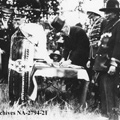Historical Overview - 1877 and After

Historian Hugh A. Dempsey notes in a Treaty 7 research report for the Treaties and Historical Research Centre at the Department of Indian Affairs that one of the First Nations leaders present at the Treaty 7 negotiations was a Kainai (Blood) chief named Father of Many Children. Father of Many Children was keeper of the tribal calendar and as such was charged with naming the year after the most profound event that took place in it. 1877, the year Treaty 7 was signed, was named Itsiparkap-otomiop, or “when we had a bad spring.” Treaty 7 was not considered a significant event of that year.
In the months immediately following the signing of Treaty 7 in September 1877 by the Nakoda (Stoney), Tsuu T’ina (Sarcee), and the First Nations of the Blackfoot Confederacy, the mood among the Plains Peoples was one of optimism. The leaders of the Plains First Nations had come away from the treaty talks satisfied that they would receive compensation for the lands used by European settlers, and that they would receive adequate food supply, cattle, farming equipment, and education to help the First Nations build a new life in the face of diminishing bison herds. What the First Nations or even the Dominion government hadn’t counted on was the swiftness of the changes to the traditional Aboriginal way of life.
To the Blackfoot, ominous omens of things to come came within the first year of signing. Three chiefs who had signed the treaty, Rainy Chief, Weasel Bull, and Heavily Whipped died that year. Very little snow came in the winter between 1877 and 1878, and prairie fires, alleged to have been set by American buffalo hide hunters, pushed the already dwindling bison herds down into Montana. For the First Nations bands north of the American border, this was a disastrous event that led to starvation that year. The First Nations peoples began to question what had really happened to them when they sat down to make treaty with the Europeans.
By 1880, the Treaty 7 First Nations fully realized the restrictions inherent in reserve lands. For years afterwards, the First Nations struggled with government representatives over the borders of the reserve lands they had been given. The Nakoda, for instance, did not like the idea of being restricted to one piece of reserve land, as the Nakoda are comprised of three distinct First Nations. They petitioned for separate reserves, and finally won separate reserve lands in 1946 and 1947. New land agreements were negotiated with the Siksika (Blackfoot), Kainai, and Tsuu T’ina, in which reserve lands were moved, added or surrendered. A great deal of confusion has persisted over the question of land, which is really not surprising when one considers that the Treaty 7 First Nations leaders had not gone into the treaty talks thinking they were giving up anything more than permission for European settlers to have some land set aside for farming.
Another contentious issue for First Nations People was the connection between Treaty 7 and the 1876 Indian Act. Once the Treaty 7 Peoples began life on reserves, they found themselves placed under the supervision of federally appointed Indian Agents, who strictly governed all life on the reserve. This was never mentioned in the Treaty terms, so the Treaty 7 First Nations had no warning that their lives would be controlled in such a manner, and they had no opportunity to agree or disagree with such a system.
For the government, the years following 1877 would see government officials dealing with First Nations’ demands that the Crown keep the promises it made, both written and verbally, during the Treaty 7 negotiations. The government was swiftly learning that it had underestimated the resilience of First Nations cultural identity, and that the Treaty 7 First Nations would not quietly assimilate into the farming and homesteading lifestyle of the emerging Dominion. The promises the government had made were promises the First Nations had remembered, and reserve land claims, demands for promised treaty payments, and other contentious issues illustrated the First Nations resolve to hold the government accountable for the land it claimed in the name of the British Crown.
The years following 1877 would see great changes in the lives of peoples who had occupied the Plains for numberless generations. Two Nations, the First Nations, and the Dominion of Canada, would find themselves forever at odds over how they would co-exist on the land that both claimed as their own.
 The Heritage Community Foundation, with the kind permission of the Treaty Policy Directorate of the Department of Indian and Northern Affairs Canada, is pleased to present this feature excerpt from the video Cede, Yield, and Surrender: A History of Indian Treaties in Canada.
The Heritage Community Foundation, with the kind permission of the Treaty Policy Directorate of the Department of Indian and Northern Affairs Canada, is pleased to present this feature excerpt from the video Cede, Yield, and Surrender: A History of Indian Treaties in Canada.
With the signing of treaties like Treaty 7, First Nations peoples found their traditional territories reduced to reserve lands. How reserve land boundaries were determined is still a subject of controversy.




